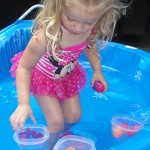Children are born curious and are constantly learning about the world around them. Children learn basic math skills through daily activities and interaction. They practice basic math skills as they notice differences between things, how events happen the same way every time, and how they can make events happen. Many parents push their children to count to ten, but teaching children to count involves more than reciting. It involves helping children understand the meaning of numbers.
Children will learn the meaning of numbers when they are developmentally ready. They might know the numbers in sequence, but are not able to use them to count. In others words, they may count to three and move four objects. Begin counting with children around the age of two to three. This helps children begin to move towards matching one thing at a time with the numbers as they say it.
Three- to four-year-old children are still learning to understand quantity. They usually can count to five and are growing in their understanding of what numbers really mean. By ages four to six, they are counting with meaning, usually matching the numbers one to ten with ten items.
Counting can be fun with your help. There are many fun activities you can do with your children to assist in learning the meaning of counting. Count socks as you sort them; count the juice boxes in the refrigerator or the cars going by. The more experience they are given, the more they will learn the meaning of numbers. Giving your child experience regularly will help them in their understanding of numbers.
To help your child get ready for math, give him/her opportunities to think about patterns and to sort things. Use items you find around the house or outside. Lay out a pattern with items such as a leaf, stick and stone and repeat the pattern. Ask your child to make the same pattern. This is a very simple but fun way to introduce math concepts. Sorting can be done easily when doing household chores. Sorting towels by color, putting small towels in this spot on the shelf and large towels in that spot are just a couple of sorting ideas.
Learning about shapes, space, and measurement are also pre-math skills you can help preschool children develop. Talk about shapes as you are walking or riding down the road. Examples: see the round stop light; this sandwich is square until we cut it in half, it then becomes a triangle. Inches, feet, and other units of measurement don’t make much sense to a young child. However, you can teach a child to measure with objects like a shoe. Have them see how long a rug is with a shoe. Then work up to giving them a ruler to work on measurement problems.
Teaching pre-math skills is easy. Recognize the curiosity in young children and use this as an opportunity to teach in a fun way.
Source: Penn State Extension; Better Kid Care, Math for Every Age.
- Youth Gain from Camping Experiences - May 13, 2015
- The Importance of Club Involvement - May 1, 2015
- Helping Young Children Understand the Meaning of Math - June 2, 2014

